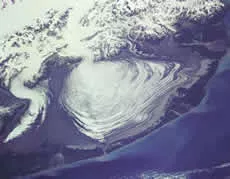Cryosphere glossary
a naturally or artificially caused increase in the thickness and/or areal extent of permafrost.
the lower boundary surface of permafrost, above which temperatures are perennially below 0 degrees Celsius (cryotic) and below which temperatures are perennially above 0 degrees Celsius (noncryotic).
(1) the geographical boundary between the continuous and discontinuous permafrost zones (2) the margin of a discrete body of permafrost.
a naturally or artificially caused decrease in the thickness and/or areal extent of permafrost.
the total geographic area containing some amount of permafrost; typically reported in square kilometers.
outermost (latitudinal) or lowest (altitudinal) limit of the occurrence of permafrost.
a region in which the temperature of some or all of the ground below the seasonally freezing and thawing layer remains continuously at or below 0 degrees Celsius for at least two consecutive years.
a region that is covered with sea ice year-round; most of the sea ice in the permanent ice zone is multiyear ice, but younger ice and open water may still be present; the permanent ice zone is what remains in summer after all melting has occurred (often called the summer minimum extent).
power of hydrogen; a measure of the activity of hydrogen ions in solution, and therefore, its acidity or alkalinity.
large ice lobe spread out over surrounding terrain, associated with the terminus of a large mountain valley glacier.
Image

The massive lobe of Malaspina Glacier in Alaska is clearly visible in this photograph taken from a Space Shuttle flight in 1989. Agassiz Glacier is the smaller glacier to the left. The Malaspina Glacier is one of the most famous examples of this type of glacier, and is the largest piedmont glacier in the world. Spilling out of the Seward Ice Field (visible near the top of the photograph), it covers over 5,000 square kilometers as it spreads across the coastal plain.
SPACE.com and NASA
an Inuvialuktun term for a perennial frost mound consisting of a core of massive ice with soil and vegetation cover; the size can range from a few meters to tens of meters, in both diameter and height; can be found in continuous and discontinuous permafrost zones.
fine-grained soil in which only a portion of the pore water has turned into ice.
part of the geologic timescale, corresponding to the time period from 1.81 million to 11,550 years before the present.